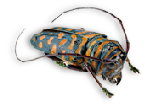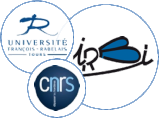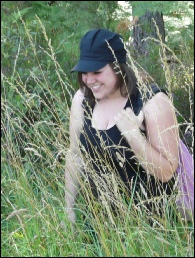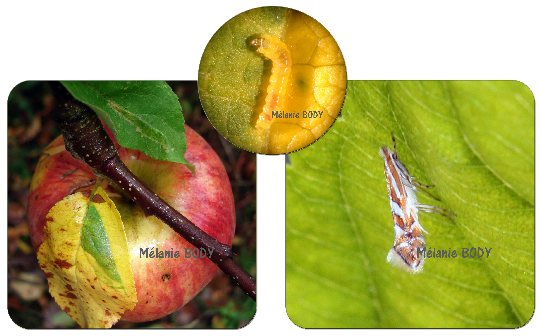









2012-2014 Teaching Assistant (ATER)CNU Section #68 "Organism Biology"
2009-2013 PhD Student, IRBI (France) – PhD supervisor: D. Giron
2008-2009 Master 2 in Insect Sciences, University François Rabelais (France)
2007-2008 Master 1 in Population Biology, University François Rabelais (France)
2009-
2008-
2007-
Keywords:
Endophagous insects; Leafminer larva; Plant manipulation; Nutrient budget; Capillary electrophoresis, Respirometry
Endophagous insects; Leafminer larva; Plant manipulation; Nutrient budget; Capillary electrophoresis, Respirometry
Plant manipulation by endophagous organisms
Research interest: Plant manipulation by endophagous organisms, Insect metabolism (leafminer larva and parasitoid metabolism), technical procedures development
My PhD research project is part of the the ‘ENDOFEED’ research program (PI. D. Giron) and aims to study plant physiological manipulations induced by endophagous insects, their underlying mechanisms and their ecological/evolutionary consequences. We work on the system Malus domestica (Rosaceae) / Phyllonorycter blancardella (Lepidoptera: Gracillariidae). Leaves of this apple tree species are naturally infected by this spotted tentiform leafminer, which is widely distributed in Europe. Endophagous larvae have the capacity to manipulate their host plant in order to generate a microenvironment with all the nutrient supply needed for its growth and its survival.
My first research objective is to characterize in deep host plant physiological manipulations in order to identify metabolic and molecular mechanisms potentially used by the leaf-miner insect to modify its host plant. This work will be completed by a quantification of plant defenses and plant nutrient within infected leaves compared to control uninfected leaves. Physiological data obtained will help us to quantify the total amount of nutrients obtained, and to establish a complete nutrient budget for the insect. Finally I will seek to estimate the impact of the endophagous life-style on major insect life history traits. The role of endosymbionts in the host-plant manipulation will also be investigated.
My PhD research project is part of the the ‘ENDOFEED’ research program (PI. D. Giron) and aims to study plant physiological manipulations induced by endophagous insects, their underlying mechanisms and their ecological/evolutionary consequences. We work on the system Malus domestica (Rosaceae) / Phyllonorycter blancardella (Lepidoptera: Gracillariidae). Leaves of this apple tree species are naturally infected by this spotted tentiform leafminer, which is widely distributed in Europe. Endophagous larvae have the capacity to manipulate their host plant in order to generate a microenvironment with all the nutrient supply needed for its growth and its survival.
My first research objective is to characterize in deep host plant physiological manipulations in order to identify metabolic and molecular mechanisms potentially used by the leaf-


Two apple tree leaves (one still green and the other yellow with a green island) infected with the tentiform leafminer Phyllonorycter blancardella larva in autumn. The white spots on the mine of the green leaf are feeding windows, where all but the epidermis has been consumed by the caterpillar. The ‘green-island’ is a feeding area where functional nutrient-rich green tissues are preserved while leaves are otherwise turning yellow. A large accumulation of cytokinins in the mined tissues is responsible for the maintaining of photosynthesis during the senescence.
Additionally, I currently investigate the metabolism of parasitoid insects throughout their life using real-time non-destructive analytical tools (respirometry) .
Publication List
Body Mélanie, Kaiser Wilfried, Dubreuil Géraldine, Casas Jérôme and Giron David, 2013. Leaf-miners co-opt microorganisms to enhance their nutritional environment. Journal of Chemical Ecology – Special issue: Microbial Interactions. 39 : 969-977. doi: 10.1007/s10886-013-0307-y
Morehouse Nathan I., Mandon Nicole, Christidès Jean-Philippe, Body Mélanie, Bimbard Gaëlle and Casas Jérôme, 2013. Seasonal selection and resource dynamics in a seasonally polyphenic butterfly. Journal of Evolutionary Biology. 26 : 175-185. doi: 10.1111/jeb.12051
Robert Christelle A.M., Veyrat Nathalie, Marti Guillaume, Glauser Gaétan, Doyen Gwladys R., Villard Neil, Köllner Tobias, Giron David, Body Mélanie, Babst Benjamin A., Ferrieri Richard A., Turlings Ted C.J. and Erb Matthias, 2012. A specialist root herbivore exploits defensive metabolites to locate nutritious tissues. Ecology Letters. 15 : 55-64. doi: 10.1111/j.1461-0248.2011.01708.x
Dupuy Fabienne, Casas Jérôme, Body Mélanie and Lazzari Claudio, 2011. Danger detection and escape behaviour in wood crickets. Journal of Insect Physiology. 57 : 865-871. doi:10.1016/j.jinsphys.2011.03.020


Institut de Recherche sur la Biologie de l'Insecte
UMR 7261 Faculté des Sciences et Techniques
Avenue Monge, Parc Grandmont
37200 TOURS (France)

Keywords :
Endophagous insects Leafminer larva
Plant manipulation
Nutrient budget
Capillary electrophoresis Respirometry
